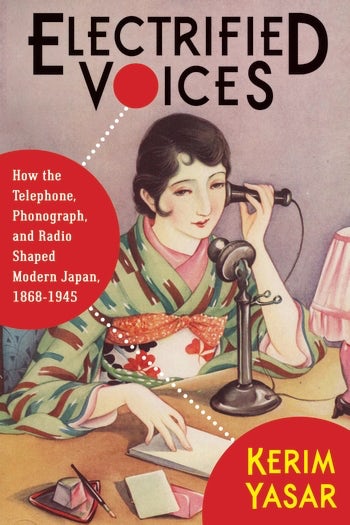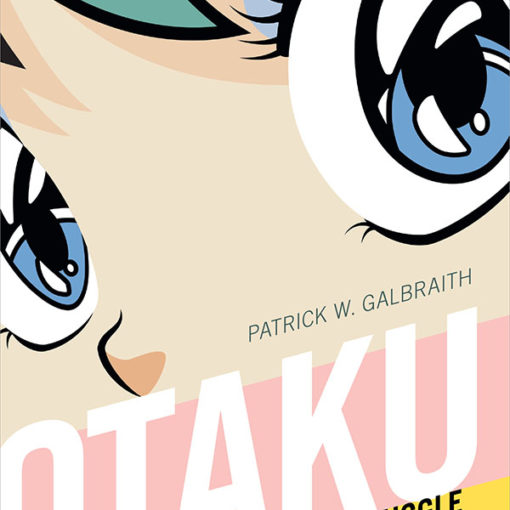Yasar, Kerim. Electrified Voices: How the Telephone, Phonograph, and Radio Shaped Modern Japan, 1868-1945. New York: Columbia University Press, 2018.
Patrick Carland-Echavarria
Kerim Yasar’s Electrified Voices is a fascinating study of how soundscapes in Japan were transformed by the introduction of audio technologies including the telephone, telegraph, phonograph, and radio between the 1870s and 1940s. Yasar argues that the emergence of audio technologies in Japan did not erase earlier traditions of orality, but instead allowed them to re-emerge and become “deeply imbricated in, and largely indistinguishable from, technologized orality.’” (7) The simultaneous development of the modern Japanese state meant that these technologies were frequently directed towards the creation and maintenance of Ideological State Apparatuses, a term Yasar borrows from Louis Althusser, and in the interest of constructing an imagined, unitary national community. In short, Yasar argues that the orality of earlier modes of performance in Japanese were revived with the dissemination of audio technologies, and that these technologies were also crucial for the cultural and linguistic development of the modern Japanese state.
Chapter 1 begins with an examination of how the telegraph and telephone, introduced in the 1870s, enabled the emergence of the modern Japanese state in the Meiji Period (40). These technologies made the newly emergent Meiji State seem ubiquitous and omniscient, actualizing its presence aurally in parts of the country where visual signifiers of Japan’s modernization may have been slower to appear. They also offered new novelties and pleasures to everyday Japanese consumers. The telephone, while initially prohibitively expensive, became highly popular through yobidashi denwa, or calls placed via public services to friends and family, a phenomenon he links to the pleasure of hearing the voices of others rather than the efficiency of the medium. (47) According to Yasar, the telegraph and telephone did not simply undermine premodern oral cultures; rather, they allowed for new modes of aural engagement and pleasure that resonated with earlier oral-textual modes of literature and performance.
Chapter 2 examines the reception of Western music in Meiji Japan. Yasar notes that Western and Japanese listeners felt a massive dissonance when they initially encountered each other’s respective musical traditions. Yet while Westerners ignored Japanese music in the 19th and 20th centuries, Meiji Period Japan embraced Western music as a pedagogical and nation-building tool. For Yasar, these differences in reception point to asymmetries in cultural power and prestige; as he writes, “the relationship between noise and music is fundamentally a political one. If music as a channeling of noise is a simulacrum of the channeling of violence into sacrifice and political order then the dismissal of the Other’s music as ‘noise’ is a political as much as an aesthetic declaration, a decomposition of the Other’s social order into chaos, violence, barbarism.” (65) Intriguingly, Yasar suggests that Western music served as both a practical tool in Meiji state-building and education as well as a conceptual vehicle of sorts for modern Japanese writers. According to him, the emphasis on harmony as vertically and horizontally articulated in Western music may have also informed notions of literary subjectivity, narrative and structure: “literary artists who had most thoroughly internalized the conventions of Western classical music also wrote the fictions that were the most complex or articulated in regard to narrative structure and linguistic texture that were the most complex or articulated in regard to narrative structure and linguistic texture.” (80)
Chapter 3 explores how the emergence of the phonograph produced legal and philosophical questions about the relationship between sound, art, and copyright. The introduction of the phonograph allowed listeners to capture, store, and sell musical performances as material objects. This helped pre-Meiji performing traditions like rakugo, Kabuki, and naniwabushi to make a comeback in the early 20th century in the form of commercial recordings that became bestsellers. It also opened up complex questions regarding the meaning of copyright, ownership rights, and what constituted an “original” work in modern Japanese law. The major focus of the chapter is on Tochuken Kumoemon, a naniwabushi performer who was paid handsomely in 1911 by a German Trading merchant named Richard Werdermann for recordings of his performances. When the record companies Tokyo Onpu Kaisha and Nicchiku released recordings of Kumoemon’s performances that were strikingly similar to those he had recorded for Werdermann, the latter sued, claiming copyright infringement. A key legal question in the case was whether existing copyright law protected individual performances, the material devices used to encode and distribute them, or both – a dilemma that underscores how notions of performance, recording and copyright impacted and reflected the rapidly changing legal and political parameters of the state. While a lower court ruled in favor of Werdermann in 1912, this was reversed by the Japanese Supreme Court in 1914, which ruled that while recordings of fixed musical performances were protected by copyright, “improvisational,” performance forms such as naniwabushi, which it argued “lacks any creative intention on the part of the performer and is expressed in a way that prevents its repeated perception,” (100) were not. Yasar argues this judgement was “based on elitist disdain for naniwabushi as an art form,” on the part of the Court and reflected a privileging of fixed textual forms over more fluid oral modes of performance in modern legal discourse. As he writes, “the legal arguments and counterarguments” of the Kumoemon case “show strongly that the medium matters in the social and cultural understanding of what constitutes both art and commodity.” (106)
Chapters 4 and 5 examine the rise of the radio in Japan. Radios, which became commercially widespread in Japan in the 1920s, allowed for an enormous range of new genres of aural performance and patterns of media consumption to emerge. Radio exercises (rajio taisô) which first began to be broadcast in 1928, quickly became widespread as “a ritual crucial to the smooth functioning of various Ideological State Apparatuses.” (120) These activities sought to construct a sense of imagined “wireless communities,” across the nation, an effort which was enhanced by the broadcasting of sporting events that “necessitated the creation of new forms of oral narrative performance.” (126) In both cases, Yasar argues, the immediacy of the radio allowed for new forms of group experience and identity to emerge. Radio voices were the catalysts through which social connections and identities were imagined; by their acousmatic nature, they were both authoritative and intimate, capable of mobilizing groups into concerted action and facilitating new modes of recreation and spectatorship. Chapter 5 focuses on radio dramas, which thrived briefly in the mid- to late 1920s before the rise of widespread censorship during Japan’s militarist turn in the 1930s. Yasar shows how the unique demands of radio drama as a genre opened it up to unique literary and artistic experimentation by artists and writers in the late 1920s. Radio dramas allowed listeners to engage with one another in an imagined community, and audience input was often key in shaping plots and narratives. The technological limitations of the genre, such as its lack of visual referents, the difficulty classically trained actors found in performing with only their voices, and the need for a high degree of fidelity in audio quality presented unique challenges for writers and broadcasters. Despite the shortness of the genre’s rise and fall, Yasar shows how theorists of sound and audio in the 1920s used radio dramas generatively to reconceptualize relationships between the visual and aural in the creation of literary texts and narratives.
Chapter 6 examines the introduction of “talkie” films in the late 1920s, which provoked vigorous debates over the proper use of music, language, and sound effects in film. Some theorists such as Nakane Hiroshi argued that films should emphasize verisimilitude and “naturalness” (shizensei) and seek a restrained balance of music and sound in their films. (203-4) Conversely, filmmakers such as Mizoguchi Kenji saw in sound films a means of contesting hegemonic discourses of the government’s language standardization policies. To this effect, he intentionally cast actors who spoke in dialect in his films as a means of subtly critiquing national language policy. These differences in perspective illuminate how sound in film was perceived and utilized very differently by various directors based on their aesthetic and political priorities. The brief ending coda examines postwar Japan as an “international laboratory of sounds,” through the global phenomenon of karaoke. Yasar describes karaoke as a “tool of depoliticized sociability and ‘self-expression,’” tying it to the decline of political activism after the 1960s. (227) Yet the presence of the human subject in karaoke, he notes, can serve as a reminder of the inherent materiality of sound, that “there are actual bodies – living, breathing, slowly dying – that generate the disembodied voices to which we have become accustomed.” (228)
Yasar’s work demonstrates that sound in Japan has a discrete and material history, one which he rightly identifies as unjustly neglected. He expands on and critiques earlier conceptions of orality by drawing on a variety of thinkers from Walter Ong to psychoanalysis-influenced theorists of the voice such as Slavoj Žižek and Mladen Dolar. His analysis persuasively demonstrates how the persistence of residual oral cultures shaped the reception of audio technologies in Japan, from the successes of Kabuki performers and benshi narrators to legal controversies over what constituted an “original” and thus copyrighted work. By drawing together the impact of technologies including the radio, telegraph, and sound in films under this rubric of technologized orality, Yasar effectively critiques prior analyses of modern Japanese language policy and the speech unification movement (genbun itchi) as merely motivated by an increasingly dominant logocentrism and a concomitant weakening of oral literary and performing traditions.
Although his theoretical reading is vast, Yasar’s analysis of orality could benefit from more engagement with other scholarship on other non-Western oral-textual traditions and their relation to Japan. For example, Yasar writes that, “it’s difficult to find a cultural community outside the Japanese archipelago that has maintained such a diversity of oral traditions throughout the period of modernization, technological transformation, and beyond.” (31) This claim to Japanese uniqueness elides a trickier question of whether Japan’s oral traditions were the product of intrinsic or extrinsic forces; that is to say, did their persistence indicate their amenability to modern audio technologies at the level of form, or did structural forces allow Japan to retain its premodern oral traditions when other cultures, by force or otherwise, could not? By framing this as a question of cultural specificity, Yasar seems to sidestep possible comparisons between Japanese and other non-Western oral and literary cultures and instead focuses on direct comparison with the West. There is also little analysis of how audio technologies were utilized outside of state institutions, such as by popular and oppositional political movements. While there is a very interesting aside about how benshi traditions evolved into the enka genre of singing during the Freedom and People’s Rights Movement in the 1880s “as a vehicle by which to promote the ideals of the Movement among the general populace,” (31) it is not pursued further.
These are small gaps, however, in a work that comprehensively catalogs the many uses of audio technologies in modern Japan and their role in the formation of new narratives genres, debates over art and creative license, and the invigoration of indigenous performing traditions such as naniwabushi and Kabuki. It is also a highly interesting work on a theoretical level, connecting the soundscapes and historical development of modern Japan in new and unexpected ways. One of the most fascinating sections of the book occurs when Yasar examines the “intensity and nonnegotiability” of how Japanese and Western listeners initially reacted to each other’s musical traditions. In such totally unfamiliar encounters where interpretation is all but impossible, he writes, “Language and music are no longer language or music but are bare sound.” (65) In this way, Yasar shows how sound is crucial in constructing the material and historical terms of intercultural engagement; we cannot understand modern Japanese history without understanding its sounds. Ultimately, Electrified Voices stands out as a timely and vital work, offering a depth of primary scholarship on the history of sound in Japan and effectively demonstrating why this history is important itself.
Patrick Carland-Echavarria is a PhD Student in the Department of East Asian Languages and Civilizations at the University of Pennsylvania. His work focuses on queer literature and cultures in postwar Japan and the United States. His research interests include Cold War-era transnational history, affect theory, translation studies, queer theory, and both modern and premodern Japanese literature.



